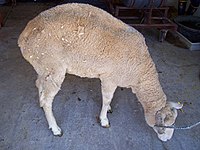
Photo from wikipedia
Nerve hydrodissection uses fluid injection under pressure to selectively separate nerves from areas of suspected entrapment; this procedure is increasingly viewed as potentially useful in treating carpal tunnel syndrome (CTS).… Click to show full abstract
Nerve hydrodissection uses fluid injection under pressure to selectively separate nerves from areas of suspected entrapment; this procedure is increasingly viewed as potentially useful in treating carpal tunnel syndrome (CTS). The usage of normal saline (NS), 5% dextrose water (D5W), platelet-rich plasma (PRP), and hyaluronic acid (HA) as primary injectates for hydrodissection without an anesthetic can limit anesthetic-related toxicity and preserve the motor functions of the median nerve. Here, we describe a novel motor-sparing neural injection and compare the effect of these four injectates for severe CTS. We retrospectively reviewed the outcomes of 61 severe CTS cases after a single neural injection with NS, D5W, PRP, or HA. Outcomes were evaluated on the 1st and 6th months postinjection, including the Boston Carpal Tunnel Questionnaire (BCTQ) scores and the nerve cross-sectional area (CSA). The results revealed that PRP, D5W, and HA were more efficient than NS at all measured time points (p < 0.05), except for CSA at the 1st month between the NS and D5W groups. Single-injections of PRP and D5W seemed more effective than that of HA within 6 months postinjection for symptom and functional improvement (6th-month BCTQ-symptom, D5W vs. HA, p = 0.047; 1st-month BCTQ-symptom, PRP vs. HA, p = 0.018; 1st- and 6th-month BCTQ-function, D5W vs. HA, p = 0.002 and 0.016, respectively; 1st-month BCTQ-function, PRP vs. HA, p < 0.001). For reducing CSA, PRP and HA seemed more effective than D5W (HA > PRP > D5W on the 1st month and HA vs. D5W, p = 0.001; PRP > HA > D5W on the 6th month and PRP vs. D5W, p = 0.012).
Journal Title: BioMed Research International
Year Published: 2022
Link to full text (if available)
Share on Social Media: Sign Up to like & get
recommendations!